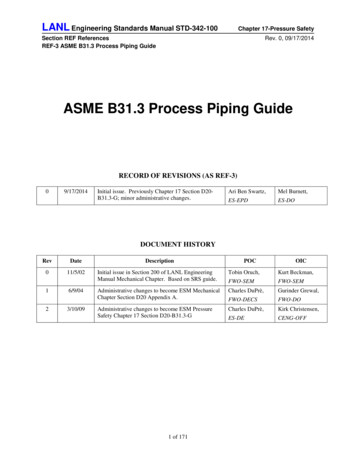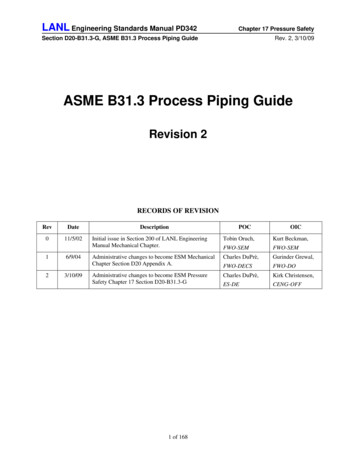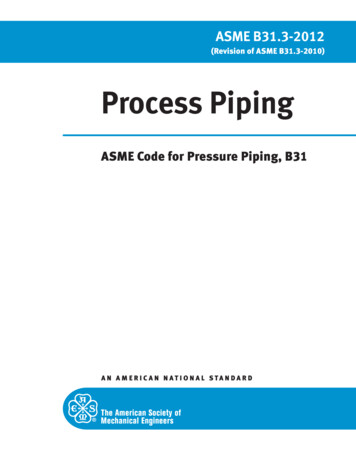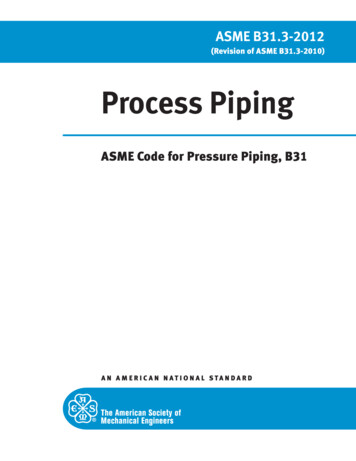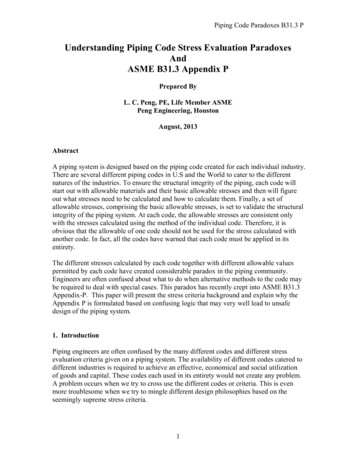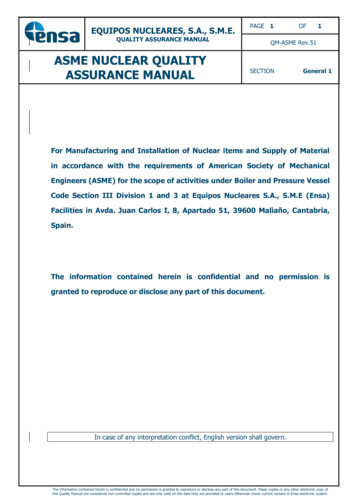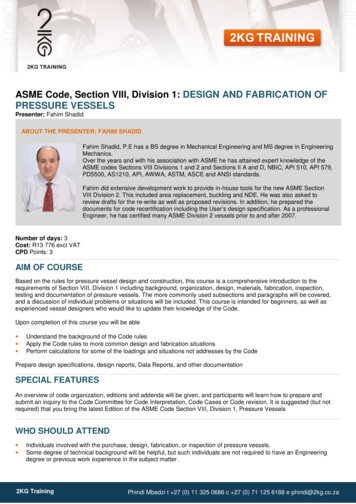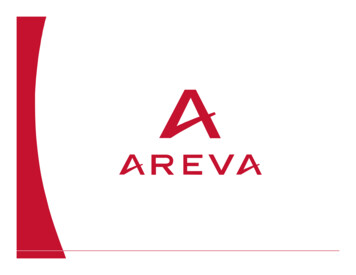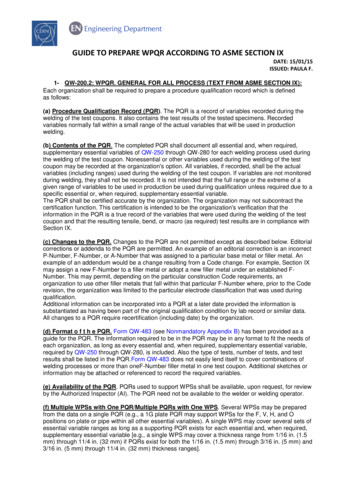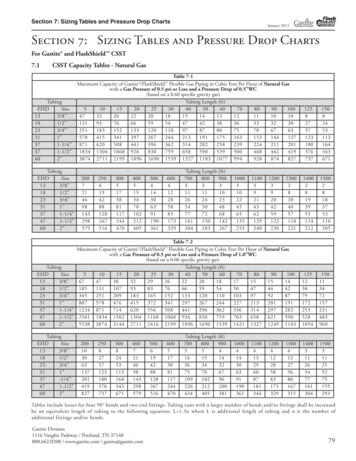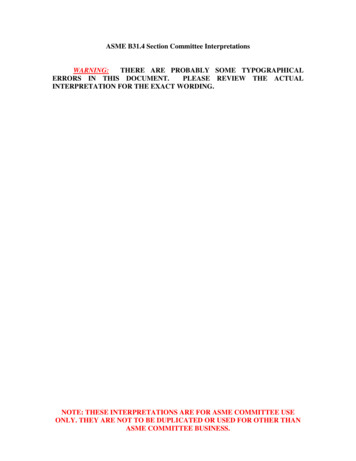
Transcription
ASME B31.4 Section Committee InterpretationsTHERE ARE PROBABLY SOME TYPOGRAPHICALWARNING:ERRORS IN THIS DOCUMENT.PLEASE REVIEW THE ACTUALINTERPRETATION FOR THE EXACT WORDING.NOTE: THESE INTERPRETATIONS ARE FOR ASME COMMITTEE USEONLY. THEY ARE NOT TO BE DUPLICATED OR USED FOR OTHER THANASME COMMITTEE BUSINESS.
Interpretation 4-1Subject:419.6.4(b), 1974 EditionDate Issued:February 9, 1978File1222Question: In 419.6.4(b), the Note refers to the net longitudinal stress. Is this to beinterpreted to mean the hoop stress due to temperature and internal pressure must beadded to the longitudinal stress using an appropriate theory of failure to obtain an“equivalent tensile stress”? This equivalent tensile stress must then be compared to theallowable stress of 90% of the specified minimum yield strength of the pipe. Pleaseinform me if this interpretation is correct.Reply: In 419.6.4(b), the designer is advised to add the compressive value of SL“directly to the hoop stress to increase the equivalent tensile stress available to causeyielding.” The intent of this instruction is to impose the maximum shear theory on thedesign criterion for restrained lines subjected to hoop stress (resulting from internalpressure) and longitudinal compressive stress resulting from restrained thermalexpansion. By the specific phrase “adds directly to” the Code’s intention is to add theabsolute values of SL (which happens to be negative) and Shoop (positive). This isconsistent with the maximum shear theory for the combining of two principal stresses ofunequal sign (the usual textbook description is the algebraic difference). The term“equivalent tensile stress” is intended to mean “two times maximum shear stress” (theASME Pressure Vessel Codes, Section III and Section VIII, Division 2 refer to this as“stress intensity.”It is apparent fro the Code paragraph that only the hoop and longitudinal stressesare considered present. Of course, if a shear stress exists (resulting from a torsion or atransverse load), then it also must be appropriately included in evaluating the “equivalenttensile stress.”NOTE: THESE INTERPRETATIONS ARE FOR ASME COMMITTEE USEONLY. THEY ARE NOT TO BE DUPLICATED OR USED FOR OTHER THANASME COMMITTEE BUSINESS.
Interpretation 4-2Subject:419.6.4(b) and (c) and 419.7Date Issued:May 25, 1978File1216Question (1): We have designed a manifold arranged piping system carryingvarious oils at elevated and ambient temperatures. Does the manifold, because of therestraint effect of ambient pipes connected to heated pipes, still fall under the criteria of419.6.4(c)?Question (2): For this piping arrangement should we also check the design of thesystem using the criteria listed under 41 9.6.4(b)?Question (3): In order to cover a general situation where aboveground piping issubject to substantial axial restraint without being rigidly anchored, should a paragraphbe added to the Code to point the reader in the right direction?Reply: The equation for SL in 41 9.6.4(b) evaluates the upper limit thermallongitudinal stress in a pipe (or any other prismatic body), in which there is absolutely noflexibility and, consequently, all the thermal expansion must be absorbed in compressivestrain. Physical arrangements complying with the requirements of "absolutely noflexibility" are: buried pipe or a straight run of aboveground pipe between two anchors.For the latter case, an analysis (computer or otherwise) based on 41 9.6.4(c) and 41 9.7should yield the same results as the equation of 41 9.6.4(b). If a piping system is properlydefined (geometry and restraints), then a flexibility analysis as indicated by 419.6.4(c)and 419.7 will fulfill the requirement of the Code. As implied above, if the system issubject to substantial axial restraints, the value of SL [from 41 9.6.4(b)] will represent theupper limit.Based on the above observations, the answers to your questions are: Question (1)Yes; Question (2)-No. Regarding question (3), the Committee will consider a possiblerevision to the Code. You are advised to review future addenda to the Code for anyrevisions.NOTE: THESE INTERPRETATIONS ARE FOR ASME COMMITTEE USEONLY. THEY ARE NOT TO BE DUPLICATED OR USED FOR OTHER THANASME COMMITTEE BUSINESS.
Interpretation 4-3Subject:419.6.4(b), 1974 EditionDate Issued:May 25, 1978File1280Question: In 419.6.4(b), would the equation for total hoop stress be: SH Sh vEα (T2 – T1) which is the result of both internal pressure and temperature change?Reply: The longitudinal compressive stress as defined in 419.6.4(b) is straininduced. The strain in the longitudinal direction causing this stress results from the freethermal expansion, α (T2 - TI), and the Poisson's Ratio contraction, vSb/E, due to thehoop strain. Since a restrained pipe does not allow these free expansions to take place, alongitudinal compressive stress is induced, namely, SL E[α (T2 – T1) - vSh/E E α (T2 –T1) - vSh. The hoop stress, on the other hand, results from equilibrium with the pressureforce. Although there is a radial expansion due to (T2 – T1) and a radial contraction due toPoisson's Ratio, these displacements are unrestrained and do not have an effect on hoopstress.Based on the above explanation, the hoop stress to be used in 419.6.4(b) is equalto PiD/2t in which it is the wall thickness of the pipe, as installed, with due considerationand allowance for the various underthicknesses and defect tolerances provided for in thespecifications approved by the Code.NOTE: THESE INTERPRETATIONS ARE FOR ASME COMMITTEE USEONLY. THEY ARE NOT TO BE DUPLICATED OR USED FOR OTHER THANASME COMMITTEE BUSINESS.
Interpretation 4-4Subject:423.2.4(b), 1974 EditionDate Issued:May 26, 1978File1257Question: Would the manufacturer's certified hydrostatic test have any bearing onthe use of a cast iron pump beyond the pressure limits defined in 423.2.4(b)?Reply: It is the opinion of the Committee that the manufacturer's certifiedhydrostatic test does not allow operation of a cast iron pump in excess of 250 psi as setforth in 423.2.4(b).NOTE: THESE INTERPRETATIONS ARE FOR ASME COMMITTEE USEONLY. THEY ARE NOT TO BE DUPLICATED OR USED FOR OTHER THANASME COMMITTEE BUSINESS.
Interpretation 4-5Subject:Scope of the B31 CodesDate Issued:November 28, 1979File1310Question: Your technical opinion is requested regarding:Crude Oil pipeline (two phase flow) with a crude oil relation of 459 m3/m3. Which is theB31 Code to be applied in order to determine the thickness of the pipeline in thefollowing cases?(a) Gathering lines, measurement lines and risers on offshore platforms.(b) From an offshore platform to 100 m out, not including the riser.(c) From 100, out to 100 m before reaching the shoreline.(d) From shoreline to 100 m off the shoreline.Your interpretation is also requested regarding paragraph (5), Clause 195.1, Part195, Title 49, as well as paragraph (1), Clause 192.1, Part 192, Title 49 of the FederalRegulations.Reply: It is the opinion of the committee that:(a) If a fluid has the operating characteristics of a liquid, ANSI B31.4 is theappropriate Code to follow.(b) If a fluid has the operational characteristics of a gas, ANSl B31.8 Code shouldbe used.(c) When a combination of the two characteristics exist, the more stringentrequirement of each code should be applied. In addition, special consideration should begiven to the effects of possible slug flow in all positions along the system.(d) In conclusion, neither the ASME B31 Code Committee nor any of its sectionsare in a position to offer an opinion as to the operating characteristics of the describedgas-oil mix or to interpret U.S. Federal Regulations.NOTE: THESE INTERPRETATIONS ARE FOR ASME COMMITTEE USEONLY. THEY ARE NOT TO BE DUPLICATED OR USED FOR OTHER THANASME COMMITTEE BUSINESS.
Interpretation 4-6Subject:437.4.1, 1974 EditionDate Issued:January 10, 1980File1385Question: An 8 hour minimum duration is required in 437.4.1. Is this necessary orpractical for components such as minfold systems, scraper traps, volume chambers, etc.?Reply: The 1979 Code contains a revision to 437.4.1 to only require a 4 hourhydrostatic test for piping and components that can be visually inspected for leaks. Webelieve this answers your concern.NOTE: THESE INTERPRETATIONS ARE FOR ASME COMMITTEE USEONLY. THEY ARE NOT TO BE DUPLICATED OR USED FOR OTHER THANASME COMMITTEE BUSINESS.
Interpretation 4-7Subject:1942 Requirements for Depth of Buried PipelinesDate Issued:February 25, 1980File1407Question: In 1942, what were the applicable B31.4 requirements for the depth ofburied pipelines?Reply: In 1942, there was no B31.4 Code. At that time, B31 requirements for thevarious types of piping were all covered in one Code, ASA B31 .l-1942. There were norequirements concerning the depth of pipelines used for the transport of liquid petroleumproducts in ASA B31 .l-1942.NOTE: THESE INTERPRETATIONS ARE FOR ASME COMMITTEE USEONLY. THEY ARE NOT TO BE DUPLICATED OR USED FOR OTHER THANASME COMMITTEE BUSINESS.
Interpretation 4-8Subject:434.5(b)(6) and 434.7.1, 1974 EditionDate Issued:October 2, 1980File1368Question: In 434.5(b)(6), a reduction of 2% of the nominal pipe diameter in sizesgreater than 12 3/4 in. O.D. is allowed by the Code for dents, and in 434.7.1(b) areduction of 2 1/2% of the nominal diameter is allowed by the Code for bends. Is the 21/2% of the nominal diameter the maximum reduction allowed for any case? Whencalculating the diameter of the sizing plate, is the allowable reduction subtracted from thenominal pipe diameter or from the inside pipe diameter?Reply: Under the 1974 Code referred to, the 2% reduction for a dent was intendedto limit the inward deformation of a short, sharp crease or depression which would havethe effect of stiffening the pipe at one point adjacent to a less rigid, undistorted area,which would result in a stress concentration. The adverse effect of a more severe dent canbe readily appreciated. The structural integrity might not be so affected by gentler andlonger ovality or out-of-roundness of the pipe, which, if it contained no stressconcentrations, might safely exceed a 2% reduction. The relative safety of out-of-roundpipe not only depends on the pipe material and service, but on the time at which it ismeasured, since it may well change during pressure testing and subsequent operations.Therefore, it would be the responsibility of the designer or operator with this informationat hand to determine what minimum diameter he can tolerate.Also, under the 1974 Code referred to, the 2 1/2% limit for pipe flattening duringbending was to govern the deformation of the bend, not a dimensional determination of asizing plate, except to state that any specified sizing plate used must be able to pass thebend. It is unlikely that one would like to use a larger sizing plate, but if they chose to doso, it would limit the flattening of the bend to less than the 2 1/2% limit. On the otherhand, if one chose a sizing plate considerably smaller than that which might contact a 21/2% reduction (which would be the generally accepted practice), the Code would stilllimit the bend flattening to the specified 2 1/2%.Neither of these paragraphs limits or determines either the minimum diameter ofany other point in the pipeline or the minimum or maximum diameter of a sizing plate ona gaging pig. If the designer or operator elects to use a gaging pig, the choice of the sizingplate diameter must be determined by him on the basis of the requirements and materialsand conditions of the specific pipeline. He is cautioned that larger-diameter, thin-wall,high-strength pipe is particularly notch-sensitive and that sizing plate contact can damagethe pipe wall internally. Control of gaging pigs in larger sizes is erratic, at best, and thepig cannot be counted on to stop at an obstruction, but may pass it with resulting damageto pipe and/or pig, making location of the fault difficult, if not impossible. To determinepipe out-of-roundness or variations in diameter at locations where they might occur,commercial equipment is available which will detect and locate these pipe anomaliesNOTE: THESE INTERPRETATIONS ARE FOR ASME COMMITTEE USEONLY. THEY ARE NOT TO BE DUPLICATED OR USED FOR OTHER THANASME COMMITTEE BUSINESS.
without a possibility of internal damage. By the use of this equipment, a scraper with asizing plate need be used only to clean the pipe of larger objects.Your second question asking about the arithmetic of sizing plate determination isno longer relevant in view of the aforementioned.NOTE: THESE INTERPRETATIONS ARE FOR ASME COMMITTEE USEONLY. THEY ARE NOT TO BE DUPLICATED OR USED FOR OTHER THANASME COMMITTEE BUSINESS.
Interpretation 4-9Subject:434.5, 1974 EditionDate Issued:October 6, 1980File1425Question: Is 434.5 of ANSI B31.4-1974 applicable to the repair of fabricateditems and pipe at the fabricating plant or pipe mill; or does this refer to repairs in thefield?Reply: Paragraph 434.5 applies only to repairs in the field. Pressure containingitems fabricated from pipe and fittings may be constructed using Chapter V as aspecification. Specifications for pipe manufacture are not covered in this Code, except asreferenced in Appendix A.Furthermore, materials purchased as fabrications from manufacturers are built tospecifications which cover such repairs.NOTE: THESE INTERPRETATIONS ARE FOR ASME COMMITTEE USEONLY. THEY ARE NOT TO BE DUPLICATED OR USED FOR OTHER THANASME COMMITTEE BUSINESS.
Interpretation 4-10Subject:435.3.3 and 401.2.2Date Issued:October 6, 1980File1452Question: Please clarify the intent of 435.3.3 of ANSI/ASME B31.4-1979, whichstates "all values and fittings on pumping units shall carry the same pressure ratings asrequired for line operating pressures," with regard to line operating pressure.Reply: Line operating pressures, as used in 435.3.3, are discussed in 401.2.2,which states:401.2.2 Internal Design Pressure. The piping component at any point in the piping systemshall
ASME COMMITTEE BUSINESS. ASME B31.4 Section Committee Interpretations WARNING: THERE ARE PROBABLY SOME TYPOGRAPHICAL ERRORS IN THIS DOCUMENT. PLEASE REVIEW THE ACTUAL INTERPRETATION FOR THE EXACT WORDING. NOTE: THESE INTERPRETATIONS ARE FOR ASME COMMITTEE USE ONLY. THEY ARE NOT TO BE DUPLICATED OR USED FOR OTHER THAN ASME COMMITTEE BUSINESS. Interpretation 4-1 Subject: 419.6.4
